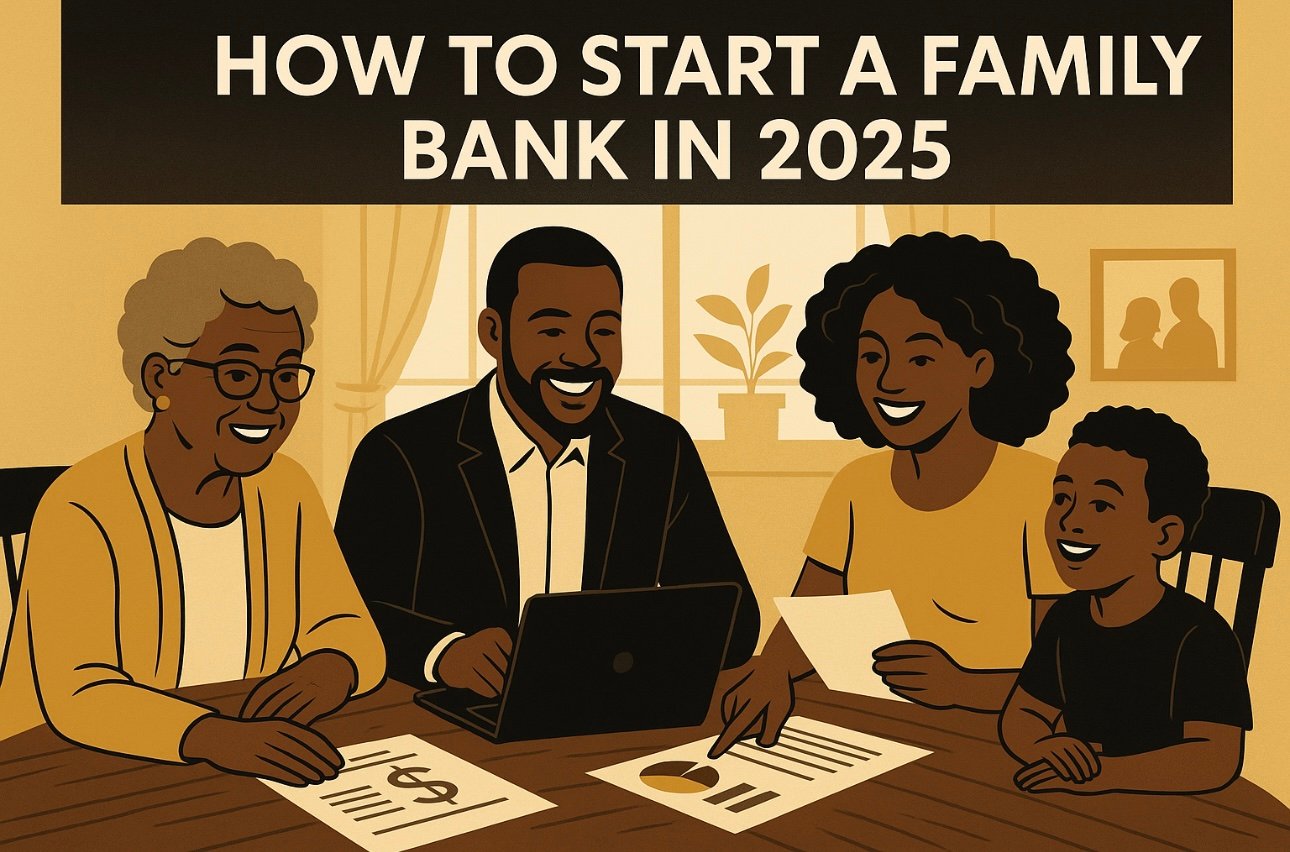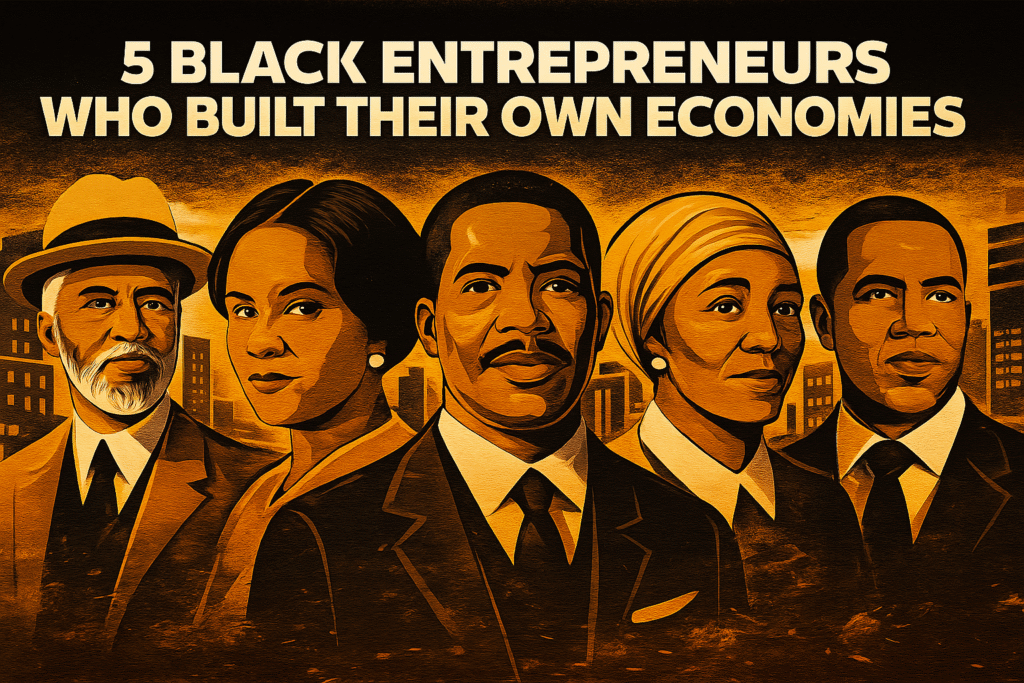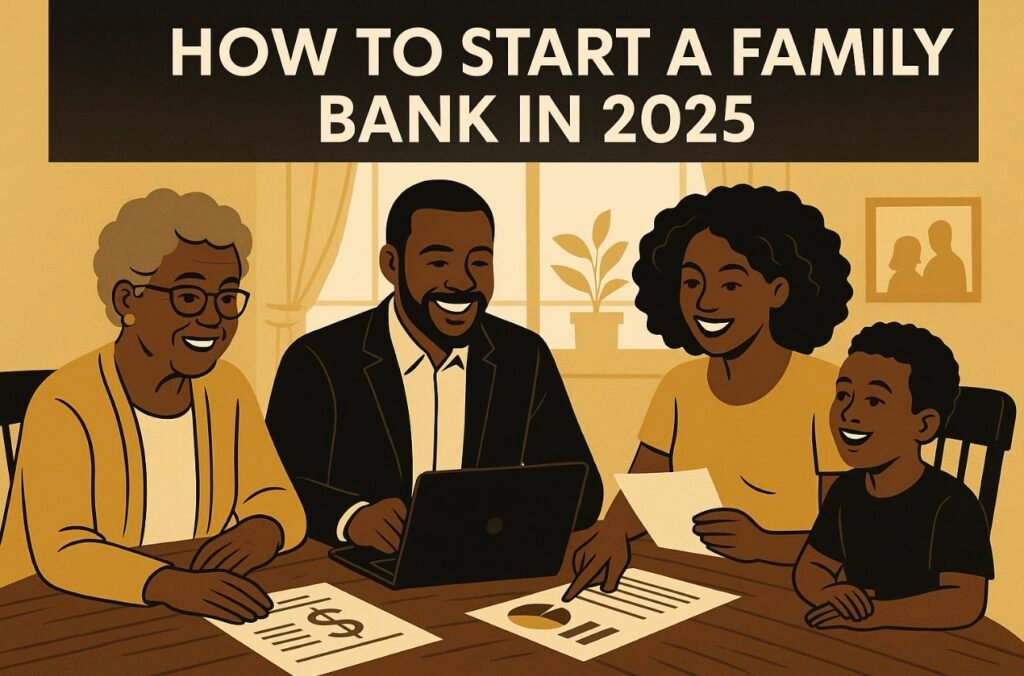Picture this: It’s Sunday dinner. The smell of baked macaroni and cornbread fills the air. But instead of talking about who brought the potato salad, your family is discussing interest rates, dividends, and how the Jones Family Bank just funded your cousin’s first food truck.
Sounds wild, right? But this is exactly what building a Family Bank looks like in 2025 — taking control of your financial future one generation at a time. Forget begging banks that never understood your story; it’s time your last name became the loan officer.
What Exactly Is a Family Bank?
No, it’s not a vault in your grandma’s basement (though she probably guards her savings tighter than Fort Knox). A Family Bank is a trust-based financial system that your family owns and controls.
It’s where family members pool money, use life insurance as leverage, and invest collectively — whether in real estate, businesses, or education — all while earning interest from each other, not the bank down the street.
It’s how wealthy families like the Rockefellers, Carnegies, and modern moguls keep wealth circulating within their bloodline.
Step 1: Set the Vision — Not Just the Vault
Before you dive into spreadsheets, gather your tribe. Sit down as a family and define what wealth really means to you.
Is it freedom from debt? Owning property? Funding each generation’s education without Sallie Mae breathing down their neck?
This step isn’t about money yet — it’s about mission. A Family Bank without purpose is like a vault with no key.
Pro Tip: Create a “Family Constitution.” Write down your values, goals, and rules. It keeps everyone accountable and aligned when the zeros start stacking.
Step 2: Choose the Right Structure — It’s Bigger Than a Savings Account
The modern Family Bank in 2025 runs on legal protection and smart tax strategy. You’ll need a few key ingredients:
- Irrevocable Life Insurance Trust (ILIT): This is your foundation. It owns life insurance policies on key family members. When they pass, the death benefit goes tax-free into the trust — fueling the family bank for decades.
- Operating Agreement or LLC: Families use this to govern how the money is loaned and repaid. It’s not just handouts — it’s structured wealth building.
- Family Bank Ledger: Track every contribution and withdrawal. Think of it like a family balance sheet — one that shows your collective growth.
Wealthy families aren’t lucky; they’re organized.
Step 3: Fund It Like a Boss
Here’s where the magic begins. Every Family Bank starts with seed money — and no, it doesn’t have to be a fortune.
💰 Funding Options:
- Start small with monthly family contributions ($50–$200 per person).
- Use life insurance cash value as collateral for loans.
- Channel tax refunds, bonuses, or side hustle income into the fund.
- Reinvest profits from family-owned businesses.
Before long, you’ll realize something powerful — the family becomes its own lender. Your niece’s college fund, your uncle’s food truck, or your sister’s salon expansion — all financed internally.
No denials. No high interest. Just legacy.
Step 4: Become Your Own Bank
This is where 2025’s digital world makes it all easier than ever.
You can use platforms like Trust & Will, LegalZoom, or Wealth.com to set up trusts. Pair that with Fintech tools like Monarch Money, Tiller, or even Notion dashboards for tracking the Family Bank.
Automate deposits. Document everything. And treat it like a real institution — because it is.
When someone borrows, they sign a promissory note. Interest gets paid back into the family pot. Your money keeps working — not just sitting.
Step 5: Teach the Game — Pass the Playbook
If only one person understands the system, you’ve created dependence, not dynasty.
So schedule Family Wealth Meetings every month.
Discuss goals, investments, and who’s up next to manage the ledger. Teach the kids how interest works and show them the family’s assets.
Because wealth that isn’t taught eventually gets lost.
“If you don’t teach your children how money works, someone else will — and it won’t be in their favor.”
Step 6: Invest Like a Community
The Family Bank’s money doesn’t just sit idle — it grows through collective investment.
In 2025, you can invest together in:
- Fractional real estate (via Fundrise or Groundfloor)
- Blue-chip stocks (via Fidelity family portfolios)
- Black-owned businesses or community projects
- Renewable energy or tech startups that align with your values
Every dollar circulating among you is a vote for your legacy.
Step 7: Protect the Empire
Once the system is rolling, you’ll want to make sure it lasts.
✅ Set up an estate plan so assets transition smoothly.
✅ Make sure the trust has a successor trustee for leadership continuity.
✅ Keep insurance policies updated to fund the bank long-term.
✅ And remember: legacy is a relay race — not a sprint.
The Family Bank in Action: A Quick Story
Meet the Johnsons. In 2015, they started pooling $200 each month into a joint account. By 2025, that account evolved into a trust-funded Family Bank worth over $400,000.
They’ve since financed two homes, a bakery, and a trucking business — all within their family. And here’s the kicker — the interest paid back made the next generation’s college fund even bigger.
Now that’s how you flip the system.
Final Word: From Survival to Ownership
Starting a Family Bank isn’t just about stacking cash — it’s about rewriting history.
It’s about saying, “We won’t wait for opportunity — we’ll fund it ourselves.”
2025 is the year families stop begging and start building.
You don’t need a billion dollars, just a billion-dollar mindset — and a plan that keeps your name in circulation long after you’re gone.
So next Sunday, when everyone’s passing the cornbread, pass around this blog too.
Because the real revolution? It starts at your dinner table.
#FamilyBank #GenerationalWealth #BlackDollarAndCulture #FinancialFreedom #LegacyBuilding











One Response
I am thankful that I detected this site, exactly the right information that I was searching for! .